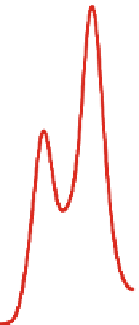Geology Reference
In-Depth Information
D1400 and D1595 (the Lukuga Group)
data-point error ellipses are 2
σ
30
133 dates (80-110% conc.)
a
b
3000
0.6
25
2600
20
2200
0.4
15
1800
1400
10
0.2
1000
5
0.0
0
0
4
8
12
16
20
0
500
1000
15
1500
2000
2500
3000
3500
00
000
200
00
207
Pb/
235
U
Age (Ma)
S1605 and S2035 (the Haute Lueki Group)
data-point error ellipses are 2
σ
30
69 dates (80-110% conc.)
c
d
3000
0.6
25
2600
20
2200
0.4
15
1800
1400
10
0.2
1000
5
0
0.0
0
4
8
12
16
20
0
500
10
00
25
3000
3500
00
0
207
Pb/
235
U
Age (Ma)
Fig. 7.12
U-Pb Concordia- and frequency age-diagrams of detrital
zircons from core-samples of (
a
and
b
) the Carboniferous-Permian
Lukuga Group, and (
c
and
d
) the Triassic Haute Lueki Group, in the
lower parts of the Samba and Dekese sections (Fig.
7.10
for sample
locations). Main age-populations are
highlighted
7.4.3.2 Mid-Paleoproterozoic (1.7-2.2 Ga)
Mid-Paleoproterozoic (1.7
-
2.2 Ga) dates are better
represented in the samples from the Dekese section (44
grains) than those from the Samba section (6 grains). This
suggests a greater contribution of Eburnian-age rock
sequences to the Lukuga Group in the Dekese section, such
as found within the Ruwenzori and Ubendian Belts in east
Africa (e.g. Lenoir et al.
1995
; Link et al.
2010
). These
Paleoproterozoic dates also overlap with similar age base-
ment rocks along the eastern margin of the CB, in Angola
(De Carvalho et al.
2000
), western DRC, Gabon and
Cameroon (Caen-Vachette et al.
1988
; Tack et al.
2001
),
and large terrains of the same age (Transamazonian) in
northeastern Brazil (e.g. Toteu et al.
2001
; Lerouge et al.
2006
). However, a provenance from westernmost Gondwana
(Brazil) is not supported by the westward paleocurrents for
the Lukuga Group (Fig.
7.15
).









































































































































































































































































































































































































































































































































































































































Search WWH ::

Custom Search